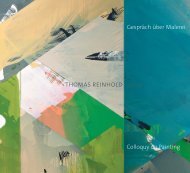Create successful ePaper yourself
Turn your PDF publications into a flip-book with our unique Google optimized e-Paper software.
experience of things. Precisely then, a chosen or applied principle can be transgressed in favour<br />
of a revealing view of things. Here the basic experience of the picture is a meta-principle. It is<br />
the liberty of things, which is formulated from attention, to which action and design contributes<br />
with an artistic sense of rules and breaches of rules. This is also the freedom of the principle,<br />
which becomes an experience and which never completely allows itself to be functionalised or<br />
instrumentalised. Precisely this fact leads to the non-abstract nature of creative reason and to<br />
an understanding of certain contemporary strivings in art.<br />
A further point is the fact that the sensations and experiences of feelings are not accorded any<br />
role in leading one to knowledge (no ideational intentionalities), while sensuality and emotion<br />
(in the act of experiencing) are both branded as (conceptually) blind, as if there were nothing<br />
in them which could itself provide orientation and open up to a determinacy of creative reason.<br />
Emotionality is then simply affection, simply reaction, a pent-up eruption. As if manifest and<br />
emotional vibration could not be and become actively instigated and readmitted to the picture<br />
as active and visible structures, and further serve as motives for action and production in a progressive<br />
and interdependent relationship. In my opinion, this is precisely what comprises one of<br />
the strengths of Thomas Reinhold. It is the progressive and interdependent nexus of intensity<br />
which can be seen coming together in chromatic frameworks and structures as an ascertainable<br />
idea for a picture, an idea which also leads thematically from picture to picture, with turns<br />
and bends. In some series of his paintings, pictorially ideational actions become still clearer and<br />
more transparent and should therefore be seen together, just as, after going from tree to tree,<br />
one eventually recognises the species of a tree, which is simply formulated in a different way in<br />
each individual specimen.<br />
1 Lacan indicates this basic experience in his story of a tin of sardines, although something else is probably to be understood<br />
there. See also: Jaques Lacan, Linie und Licht, in: Gottfried Boehm (ed.), Was ist ein Bild, Munich 1994, p. 62 ff<br />
2 See also: Kant, Kritik der Urteilskraft (‘Critique of Judgement’) A LIII, B LV (p. 107)<br />
3 Immanuel Kant, Kritik der reinen Vernunft (‘Critique of Pure Reason’) A 142<br />
4 See also, e.g.: Armin Göbels, Das Verfahren der Einbildung, Ästhetische Erfahrung bei Schiller und Humboldt, Vol. 21 Hamburger<br />
Beiträge zur Germanistik, Frankfurt am Main 1994<br />
5 See also, e.g.: XX. Deutscher Kongress für Philosophie, Berlin September 2005, Sektionsbeiträge Vol. 1 and Vol. 2, ed. Günter<br />
Abel, Universitätsverlag der TU Berlin<br />
6 Nelson Goodman, Ways of Worldmaking, Hackett Publishing Company, Indianapolis, Cambridge 1978<br />
7 ibid. Vol. 1 p. 285 ff, Sabine Ammon: Welterzeugung als kreativer Prozeß – Überlegungen zu Nelson Goodman konstruktivistischer<br />
Theorie des Verstehens<br />
8 See also: Ingo Nussbaumer: Inabstrakt vs. Abstrakt oder: Warum der Ausdruck „abstrakte Malerei und Kunst“ für einige zeitgenössische<br />
Künstler/innen inadäquat geworden ist und ein anderer adäquat werden könnte, in: Fair, Magazin für Kunst & Architektur,<br />
Abstraktion in der Malerei, Vienna, Issue 01/2018<br />
9 Kazimir Malevich, The World of Objectlessness, translated into English by Simon Baier and Britta Dümpelmann. (Hatje Cantz,<br />
Berlin, 2014)<br />
15<br />
Ingo Nussbaumer<br />
Lives and works as an artist, art theorist and colour researcher in Vienna and Lower Austria. Studied painting and philosophy<br />
in Switzerland and Austria. 1987–1989 director of the Vienna branch of the Free International University (FIU) founded by Beuys<br />
and Böll. 1995–1996 discovery of unorderly spectres and the structural phenomenology of their context. Publications include 2008<br />
Zur Farbenlehre (‘On the Theory of Colour’), Edition Splitter, Vienna. Since 2013 lecturer at the University of Applied Arts in Vienna.<br />
Numerous publications and books, as well as exhibitions in Austria and abroad.<br />
www.ingo-nussbaumer.com



